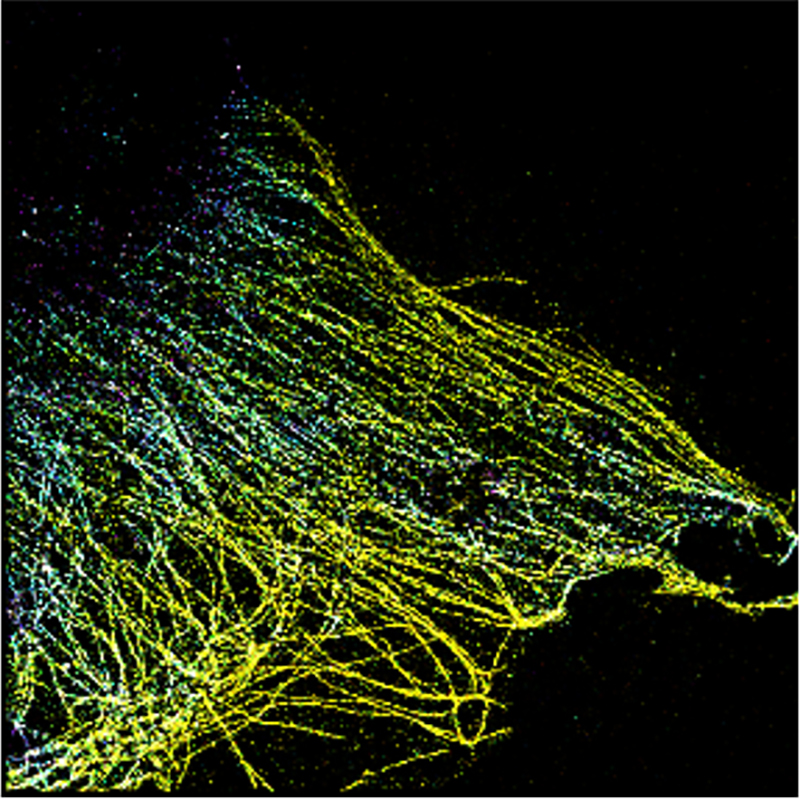New microscopy technique reveals living cells in 3D molecular detail
Living cells can now be visualised in three-dimensional molecular detail, enabling new insights to cellular structure and behaviour.
Living cells can now be visualised in three-dimensional molecular detail, enabling new insights to cellular structure and behaviour.

Researchers from ╣·├±▓╩Ų▒ Medicine & Health and ╣·├±▓╩Ų▒ Science have developed a new method to visualise living cells in three-dimensional clarity ŌĆō at the subnanometre scale ŌĆō by ŌĆśfocus-lockingŌĆÖ on samples while they are being recorded.
Described in , the new focus-locking technique involves growing cell on glass coverslips with specially 3D-printed subnanometre particles called ŌĆśfiducialsŌĆÖ, which act as markers to stabilise or ŌĆślockŌĆÖ the microscope as it is recorded.
This technique, used together with the active stabilising microscope developed previously by the team, overcomes current shortcomings of super-resolution imaging, which result in ŌĆśsample driftŌĆÖ ŌĆō the accumulation of distortions which ultimately degrade final resolution of images.
Previously, the ╣·├±▓╩Ų▒ team designed a smart microscope using polystyrene beads embedded within sample as guides to help the microscope continuously re-align ŌĆō up to 12 times per second.
With this technology ŌĆō reported earlier in and ŌĆō the researchers were able to push the limits of existing super-resolution fluorescence microscopy.
Now, the team have further extended the capabilities of this technology by replacing polystyrene beads with guide markers ŌĆō 3D-printed to nanoscale accuracy ŌĆō to lock the focus to within a nanometre.
As the authors report in Nature Communications, the 3D focus-lock mechanism enables imaging beyond the surface of the cell to provide a 3D view of distinct molecules inside a cell, including living cells.
Being able to control the 3D-architecture and positioning of the guide markers at the nanoscale means that microscopists have greater control of the imaging.
Being able to image the cell volume in high resolution should allow researchers to better observe the internal dynamics of cells, such as the trafficking of signalling proteins (the cellŌĆÖs communication) in response to encounters with pathogens.
ŌĆ£A major benefit is that we control where the markers are located, ensuring there is one within the field of view, and we can customise them for our purpose,ŌĆØ said team co-lead, Dr Simao Pereira Coelho, who co-led the research at the EMBL Australia Node in Single Molecule Science in the ╣·├±▓╩Ų▒ School of Medical Sciences, and is currently at Instituto Gulbenkian de Ci├¬ncia in Portugal.
A fabrication method called direct laser writing enables this precision.
ŌĆ£While direct laser writing is becoming very popular, we have coupled it with single-molecule imaging for the first time. Other fabrication techniques have not been able to provide this level of detail and accuracy,ŌĆØ Dr Pereira Coelho said.
ŌĆ£This represents an accuracy that is better than the localisation precision of any previously reported single-molecule method to date,ŌĆØ said the late Scientia Professor Katharina Gaus, who led ╣·├±▓╩Ų▒ŌĆÖs EMBL Australia Node in Single Molecule Science and co-led this research team.
ŌĆ£This solution to a fundamental imaging problem bridges the gap between high-resolution and penetration depth that can be used for imaging of living cells.ŌĆØ
Prof. Gaus sadly passed away before the study was published and Prof. Justin Gooding from ╣·├±▓╩Ų▒ ScienceŌĆÖs School of Chemistry and the Australian Centre of NanoMedicine took on the role as senior author.
╠²